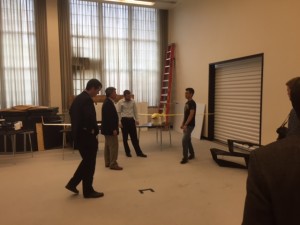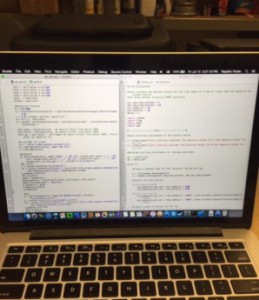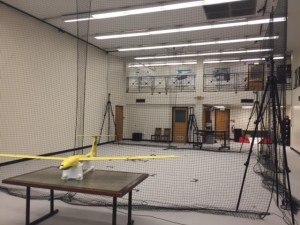This week was a lot busier as we started lab work in earnest. I’ve been helping with various tasks around the lab in preparation for RECUV’s next string of deployments, which will start soon after I leave. I was introduced to RECUV’s other lab across campus, where they test rovers and small drones in an indoor flying space. The area is surrounded by infrared motion cameras which track the position of the aircraft within the room. The drones that are flown indoors are rotary-wing, meaning that they use rotors to generate lift rather than wings. RECUV has a small fleet of helicopters and multirotors, which are helicopters with more than one rotor. They are controlled by a person with a wand, which the aircraft tries to stay about a meter in front of at all times.
On Monday, we were privileged to receive a visit from Senator Cory Gardener, who was on a tour of various science programs at CU. We showed him our fleet of aircraft and Dr. Frew gave a presentation about RECUV and its goals. After the presentation, I flew a Firewheel quadrotor as part of the demonstration, using the wand to guide the aircraft around the room. After the Senator and his party left, we returned to the Fabrication Lab in order to continue work on the projects we had started last week.

Senator Gardener being shown RECUV’s fleet of aircraft
During the beginning of the week, James and I worked on finding a new battery for our launching winch. We ended up taking apart a few other batteries and soldering together the strongest cells to build a new battery. After that, we made adapters to the winch’s power supply and successfully tested the new battery that we had made. The rest of the week I spent learning the programming language Python, which I used to create a program that creates fake but realistic GPS data that can be used in conjunction with RECUV’s autopilot simulator to simulate the control van moving around.
With some help, I also developed an interface to Google Earth so that we can see the “van” moving as the program generates new coordinates. Once the simulator has a “vehicle” in it, we can see how the autopilot reacts to following a vehicle, which is an important part of the upcoming deployments. James and I also tested more antennas, and found that a wifi link is probably the best way to communicate with the Tempest as it follows the van.

Some of the code I worked with this week. On the left is the program that I was using to help me with the interface to Google Earth. On the right is the program I wrote to generate GPS information.
Next week, we plan on running the simulations and, if they are successful, we might start flying again towards the end of the week to make sure that aircraft can actually follow a vehicle as we need it to. I’m looking forward to seeing what we worked on this week being put into practice!


There are no comments published yet.